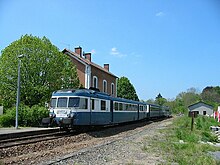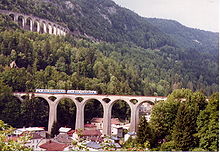SNCF X 2800
The X 2800 series of the French state railway SNCF was a series of diesel multiple units that were in scheduled service from 1957 to 2009. As the most powerful one-piece, single-engine diesel railcar at the time, it was designed for use with up to four sidecars on demanding mountain routes.
History and description

A total of 119 railcars of this series were built, of which the numbers X 2801 to X 2816 were built by Decauville , all others by Renault . First they were called U 825, the U for "autorail u nifié" (unit railcars) and the number for the performance of the diesel engine in HP stand. The 53 t heavy railcar had 12 seats in the 1st and 50 seats in the 2nd carriage class as well as a baggage compartment; it was 27,730 mm long with buffers . The car body rested on two two-axle bogies. It was originally red below the ribbon window, otherwise it was cream-colored with a V-shaped tip on the fronts; the roof section was later also painted red. From 1976 the red areas gave way to a dark blue, the window band turned gray with white edges.
The diesel engine from MGO (MAREP-Grosshans-et-Ollier) had an output of 607 kW, it was installed behind driver's cab 1 above the motor bogie. The power was transferred hydromechanically by means of a Mekydro four-speed gearbox, the maximum speed of the railcars was 120 km / h.
As part of modernization measures from the mid-1970s, among other things, the chestnut brown bench seats were replaced by orange-colored individual seats and the green of the interior gave way to warmer colors. The railcars were upgraded for double traction and as such could also have a trailer car as an intermediate car.
With the shutdown of the ETG - Turbotrains between 1980 and 1986, X 2800 took over their tasks. For this purpose, the maximum speed of fifteen units was increased to 140 km / h.
On August 3, 1985, the X 2821 railcar collided head-on with a passenger train at Flaujac-Gare due to human error . There were 35 dead and 120 injured.
In the summer of 2008, the X 2866 and X 2895 railcars were used in Switzerland . The transport company Travys could not operate the traffic between Le Pont and Le Brassus with electric vehicles due to work on the relevant substation . However, replacement traffic on the road would have required the use of at least a dozen buses. Therefore, one turns to the SNCF, whose X 2800 were approved for Switzerland. Travys has sent drivers and technicians to Besançon beforehand for training. The two rented railcars were used in double traction for several weeks in June. On the route with ramps of up to 12 ‰, they kept to the timetables of the electric vehicles despite numerous stops (in the absence of a stop request signal, the driver stopped at every station).
1st class railcar

The railcar X 2808 was equipped in 1957 for high-quality express services between Poitiers and La Rochelle . It was the first of a total of twelve X 2800 to become a pure 1st class vehicle and received three appropriately equipped Unifié 56 type sidecars, each with 54 seats. The red areas in the standard version and the roof were painted in a light olive green in accordance with the RGP, and straw yellow was chosen for the window band instead of cream. Above and below the ribbon of windows, the different colored surfaces were separated by a gray decorative strip made of metal.
The X 2808 was named " Aunis " after its area of operation , this designation was affixed to the sides and fronts of the railcar. In the five years of his service on the La Rochelle – Poitiers route, he covered 588 km a day between the two endpoints, with two round trips. With 6½ hours a day on the route, more than 200,000 km a year came together.
In 1958, a second such train was built with the X 2816 multiple unit, but it was painted vermilion / cream. It was first used from Saintes to Angoulême , in the summer months also to Royan and, if necessary, to Limoges or between Angoulême and Limoges. With less than 80,000 km per year, its mileage was significantly lower than that of the X 2808. In 1962 it was repainted in its colors and supported the latter on its regular route from autumn of that year.
From 1967, the two trains were withdrawn from there and replaced by two-class Caravelle multiple units and through trains from Paris . They finally came to Lyon via Saint-Étienne , from where they were used as “Il Piemonte” in the cross-border express service to Turin .
Other pure 1st class vehicles were the olive green / straw yellow painted railcars X 2814 and X 2897 to X 2900 as well as the X 2860, X 2901, X 2902, X 2913 and X 2915. In the 1970s, the former 1. -Class railcars converted into the two-class standard version and used in "normal" operation.
Storage and whereabouts
From 2003 the railcars were parked, with the X 2830 and X 2900, the last two were in regular use on April 6, 2009 between Besançon and Valdahon . Three railcars were not restored after accidents and retired early: X 2821 (1985), X 2841 (1990) and X 2913 (2007).
Several of the vehicles remained in museums or for tourist traffic .
Web links
Individual evidence
- ↑ Un autorail nommé Aunis in: Ferrovissime 94, p. 72 ff.
- ^ A b Georges Mathieu: Le matériel moteur de la SNCF . 1st edition. Éditions La Vie du Rail, Paris 1992, ISBN 2-902808-48-8 , p. 222 f .
- ↑ X 2800: l'équation suisse in: Ferrovissime No. 8, p. 55 ff.


